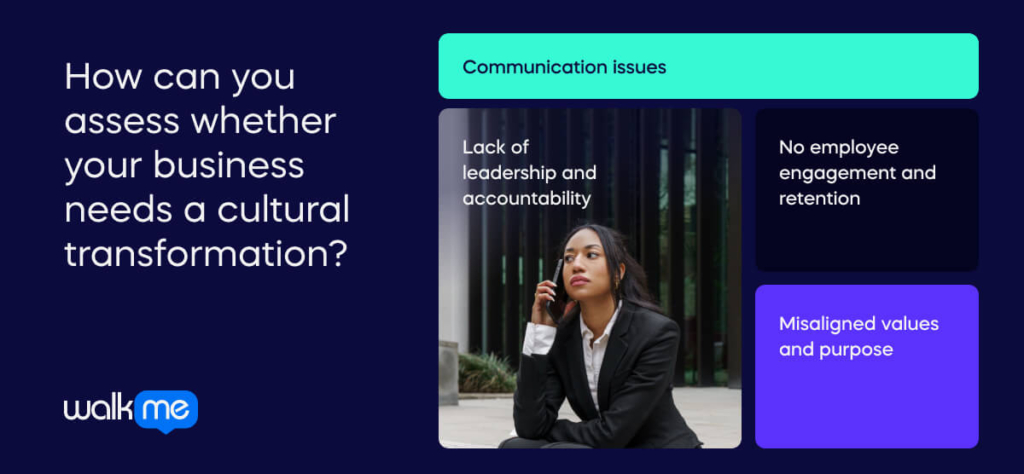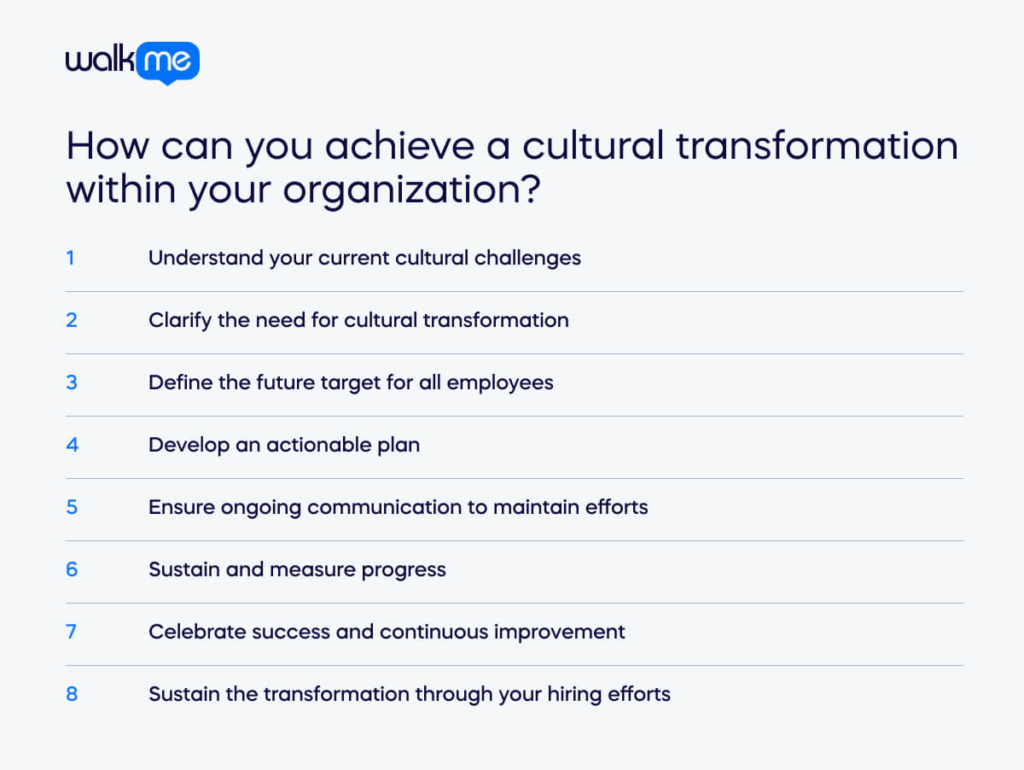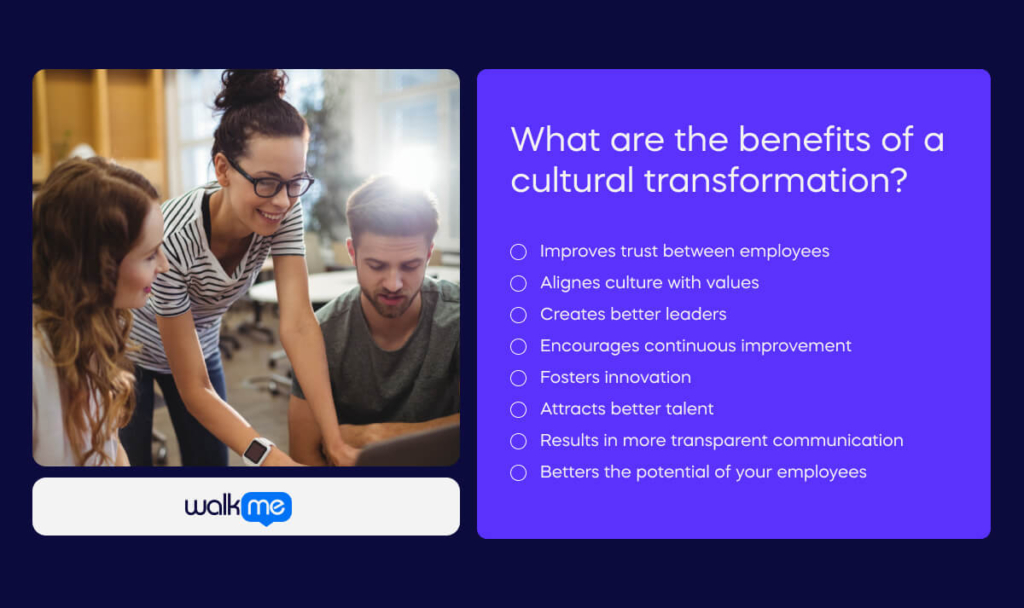Company culture is a crucial part of how every organization operates. Sometimes, this culture needs to change to improve satisfaction and boost employee productivity. Culture transformation can happen across the whole organization or within specific departments and teams.
It involves changing the hearts, minds, and skills of employees to support the new cultural change. Employees need to want to change and understand what the change looks like. They also need to have the tools to make the change.
So, cultural transformation is more than a buzzword. It’s a commitment to creating a culture where employees feel they belong. It is also one where they can invest in the organization’s long-term success.
In this guide, we will examine cultural transformation and why it matters. We will also discuss how to know when your business needs one. Next, we will consider how to implement it and the benefits and challenges involved.
What is cultural transformation?
Cultural transformation starts when an organization realizes its current culture no longer matches its vision, mission, values, and goals. This mismatch shows leaders that the culture is blocking progress.
To fix this, a business must change its organizational culture to better align with its goals. Once you do this, you can make the business productive and efficient again.
What is the importance of a cultural transformation?
Cultural transformation is important because, when done right, it helps the organization find a common purpose and values. These shared purposes and values help promote the desired behaviors.
This is true whether it is updates to your business strategy or a new structure in the organization. These changes bring people together in new ways, creating new norms and beliefs that shape your company culture. The best organizations don’t wait for problems to change their culture. They make it a regular part of their strategy.
Focusing on a cultural transformation can also benefit companies even if they haven’t started major transformations yet. An adaptive culture sets the stage for transformation. It helps overcome issues from incomplete growth or problems in different regions in a proactive way.
How can you assess whether your business needs a cultural transformation?

Various indicators would show that your business requires a cultural transformation.
The main signs are:
Communication issues
A lack of transparent communication and cross-functional collaboration can lead to inefficiencies. For example, a company struggling with interdepartmental communication might experience misaligned projects and missed deadlines due to conflicting instructions or a lack of information sharing.
When people are unwilling to communicate during crises or when they silo information out of fear, a culture change is necessary.
Lack of leadership and accountability
If a team or business unit fails to meet business goals, it may be a cultural problem. Disconnected top leadership setting unrealistic expectations can hinder progress.
A lack of accountability can also prevent the execution of business strategies. Addressing these issues is crucial for achieving the desired outcomes.
No employee engagement and retention
Unhappy employees result in low productivity and high turnover. This negatively impacts the company’s bottom line. A toxic work environment where employees feel overworked also makes it hard to keep top talent.
Proper employee onboarding and a strong company culture are vital for retaining new hires. Employees who feel they belong are likelier to stay and contribute to the organization’s development.
Misaligned values and purpose
Unclear values and purpose make it difficult for new employees to build loyalty. This leads to high employee turnover rates among new hires. Losing less experienced or less motivated employees may seem minor. But, it risks losing potential high performers and incurs high turnover costs.
When leadership does not align with the organization’s mission and values, it creates confusion. For instance, a company that claims to value work-life balance but does not allow employees to take time off may struggle to attract and keep top talent.
How can you achieve a cultural transformation within your organization?

Once you recognize the need for cultural transformation, follow these steps to ensure success:
Understand your current cultural challenges
Before starting a transformation, understand the cultural difficulties and what employees think about them.
CEOs and executives may have different views on these challenges than employees. To get a sense of your current culture and challenges, survey employees, conduct focus groups, and hold meetings with team leaders.
Clarify the need for cultural transformation
Ask yourself why you need a cultural transformation and determine how it will help achieve long-term goals. Creating a vivid picture of the required future state is an important early step. Leaders must define the desired culture using previous employee feedback. This definition should be specific and flexible enough to influence performance across the organization.
Define the future target for all employees
Start by defining the target front-line culture. Identify the forces (leadership, systems, processes) that will support it. Get input from front-line employees about what they value. Find out how culture impacts their performance.
Effective communication is critical. Use many channels to reach everyone and gain buy-in. Enlist supporters at all levels to serve as agents of the change. These team members can help spread the word and model desirable behaviors. They can also gather feedback for continuous improvement.
Develop an actionable plan
Create a strategy that translates into an actionable plan. Focus on the positives of your current culture and the major points you want to change. Map out desired goals without going overboard.
Start with a limited, achievable number of clear, actionable, and measurable goals. Cultural change must be rooted in business context and rationale. Link behavioral indicators to business-focused KPIs for timely, actionable information.
Ensure ongoing communication to maintain efforts
For cultural shifts to become a reality, visually depict the future path. Represent every function, division, and discipline across the enterprise. Ongoing, active communication is crucial.
Extensive communication strategies should invite all levels to understand and clarify the cultural impact of their roles. Leaders set behavioral norms that reflect organizational values. Every level of leadership must support the transformation. They should emulate the desired behaviors and embrace new systems.
Sustain and measure progress
Understand that cultural transformation is a process. Meaningful and sustainable change takes time. Make awareness-building and alignment a regular part of the planning cycle. Share what leaders can expect within certain timeframes.
Focus on changing behaviors, not just shaping attitudes or developing values. Ensure that incentives reinforce desired behaviors. Revise all key systems, including recruiting, assessment, performance improvement, and development.
Celebrate success and continuous improvement
Set short-term goals alongside long-term ones. Achieve and recognize success to strengthen support for changes. Quick wins further engage employees and maintain momentum. Recognize that cultural transformation is a marathon, not a sprint. People are more excited about change efforts when they create the desired culture.
Adequately resource the work for the long haul. Cultural transformation initiatives may take over three years, depending on their breadth and depth. Measure progress and celebrate breakthroughs along the way. Treat this workplace transformation as a continuous process and reinforce it by recognizing positive effects.
Sustain the transformation through your hiring efforts
Focus on hiring people who fit the organizational culture in your recruiting efforts. Include a cultural fit assessment to identify candidates who align with the new culture in the recruitment process. Invest in continuous development to strengthen competencies supporting the new culture.
What are the benefits of a cultural transformation?

The main benefits of a successful cultural transformation include:
Improves trust between employees
Trust is a key driver of high-performance organizations. Integrating trust into your cultural transformation fosters a sense of community among employees.
When employees trust each other and their leaders, they communicate more openly. This trust leads to more effective teamwork and problem-solving. Employees feel comfortable sharing ideas and feedback without fear of retribution.
Alignes culture with values
A strong, aligned culture upholds the organization’s values and goals. This creates a more cohesive and effective workplace. For example, a company that values diversity and inclusivity attracts a diverse workforce.
This fosters a creative and innovative environment. Employees who see their values reflected in their workplace are more committed to their work. This alignment helps keep top talent and enhances job satisfaction.
Creates better leaders
Good democratic leadership is essential for creating a healthy culture. Leaders who embody the company’s values set a positive example for their teams. A strong culture shapes fair leaders who promote the business.
They do this by maintaining integrity and demonstrating the organization’s core values. Happy employees are productive employees. A true cultural transformation instills confidence in your staff and encourages hard work and loyalty. Leaders play a critical role in this transformation by communicating the vision. They can also encourage participation and recognize achievements.
Encourages continuous improvement
Cultural transformation becomes an iterative process when done periodically. This ongoing approach makes it easier to discover and assess issues before they become significant problems.
Regularly refining your culture allows for continuous improvement and adaptation to changing circumstances. This proactive stance helps maintain a dynamic and resilient organizational culture that can quickly respond to new challenges and opportunities.
Fosters innovation
Global competition and business challenges affect every organization’s strategic plan. A culture that encourages creativity and experimentation leads to increased innovation and problem-solving.
When employees can try new things, they are more likely to devise innovative solutions. This culture of innovation helps the organization stay competitive and adapt to market changes.
Attracts better talent
People gauge your culture from employee satisfaction, candidate experience, and customer treatment. A healthy culture promotes loyalty and attracts more candidates. Improving work culture helps with employee retention, productivity, and company success.
High employee satisfaction leads to better performance. Positive candidate experiences attract top talent. A strong customer-centric culture also improves client satisfaction and loyalty.
Results in more transparent communication
A good transformation process improves communication throughout the organization. Individuals and teams understand, articulate, and adopt the organization’s purpose, which they then model to clients and stakeholders.
This transparent and consistent communication ensures everyone is aligned with the company’s goals. Effective communication leads to more efficient processes, improved customer service, and supports growth and scaling. Clear communication channels help prevent misunderstandings. It also ensures that all employees work towards the same objectives.
Betters the potential of your employees
Encouraging a positive culture unlocks your workforce’s full potential. Employees who feel like their views matter are more likely to remain motivated, leading to higher productivity and innovation.
Minimizing expenses through improved efficiency and reduced turnover also contributes to a better bottom line. A positive culture creates a cycle where motivated employees drive better business outcomes. This, in turn, reinforces the positive culture. This sustainable approach ensures long-term success for the organization.
What are the challenges of a cultural transformation?
But, implementing a cultural transformation comes with its challenges.
These are:
Resistance to changing a set-in-stone culture
Changing an organization’s culture can be difficult, especially if the current culture has been in place for a long time. Overcoming organizational inertia and creating momentum for change is challenging.
Employees may resist changes to the business transformation. This resistance makes it harder to put in place the transformation. For example, a company attempting to shift to a more open and transparent culture might struggle. This is the case if employees prefer a more hierarchical structure.
Lack of leadership alignment
Leadership must agree with the new way of evolving organizational culture. Leaders need to agree on the desired culture, how they will drive it, and the commitments they are willing to make. Without unified leadership, cultural change efforts are likely to fail.
The difficulty of making the transformation more human
Assuming the success of a change initiative without considering its impact on people dehumanizes the business. Employees often feel uneasy about changes. They may fear redundancy, scrutiny, or the effort required for implementation.
This unease can lead to reduced productivity during the adjustment period. But, creating an internal movement that motivates employees to work together can mitigate this challenge.
Ineffective communication
Effective communication is essential for cultural transformation. Organizations often struggle to communicate their vision and strategy well. Poor communication leads to confusion, resistance, and lack of engagement. Clear and consistent messaging helps ensure everyone understands and supports the change.
Costly investment in time and resources
Cultural transformation is complex and time-consuming. It requires large investments in time and resources. For instance, implementing a culture of continuous learning requires regular training resources. Organizations must recognize that cultural transformation is not a one-time project but an ongoing effort.
Sustaining the transformation in the long-term
Sustaining cultural change requires processes to support the change. Organizations often underestimate the rigorous processes and disciplines needed after launching cultural initiatives. Without the necessary investments and commitment, achieving sustainable change is unlikely.
Impact on employee morale
Shifting organizational culture can disrupt normal operations and impact employee morale. For example, implementing a more agile and flexible culture may encounter resistance from employees who prefer stability and structure. This resistance can lead to confusion and decreased productivity. Addressing these concerns proactively helps maintain morale and smooth the transition.
Ignite a cultural transformation at your company
A successful cultural transformation requires a customized approach. Each organization has unique dynamics and challenges. Using a generic strategy often fails and can face resistance from employees.
Key factors include understanding the organization’s specific context, such as industry and market position. These elements shape its culture. Strong leadership and clear core values are essential. Leaders must model the desired behaviors.
Employee engagement is crucial. You should involve all employees in shaping and supporting the transformation. Next, tailor a cultural transformation strategy with clear objectives and actions. Clear, transparent communication is vital to ensure employees understand and align with the changes.
Cultural transformation takes time, but the rewards are worth it. Don’t wait until your culture fails to make changes. Instead, track and manage your culture to help your organization achieve its goals.


